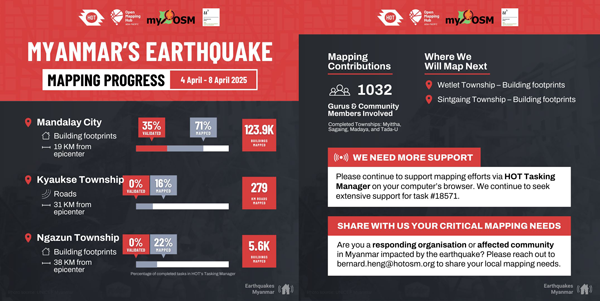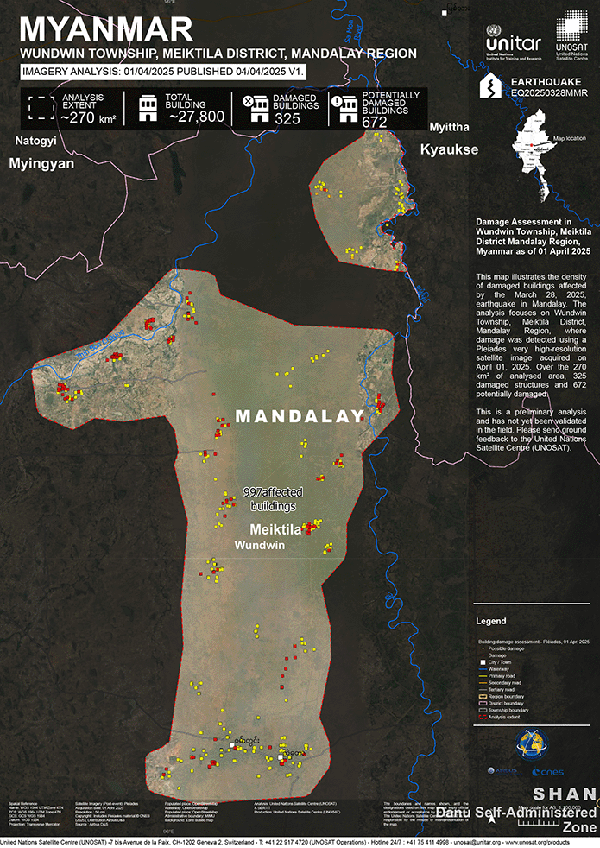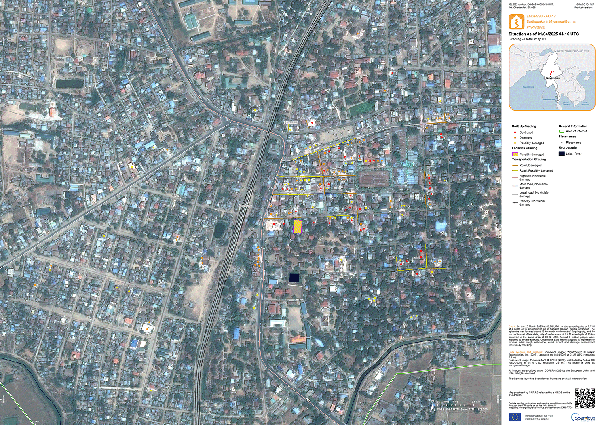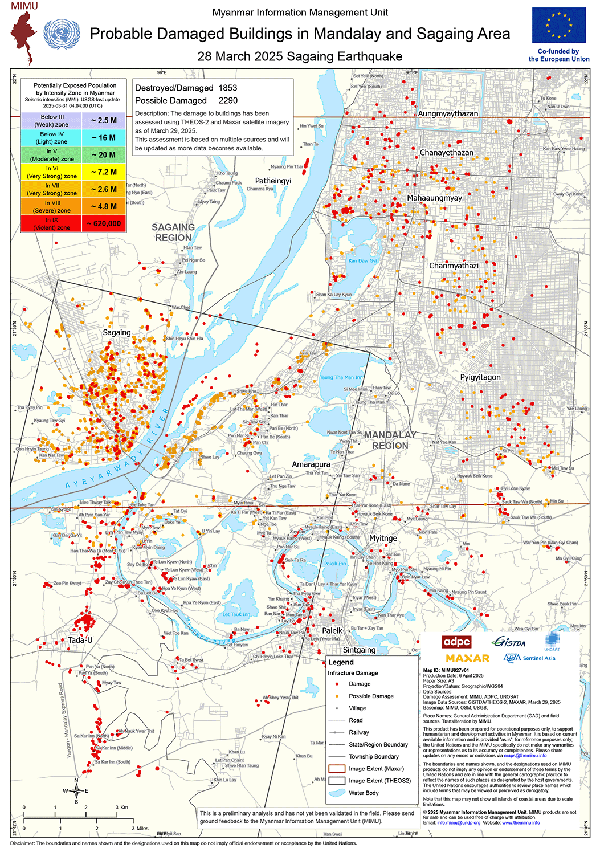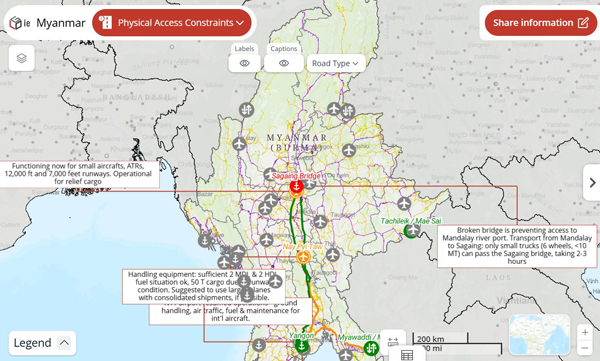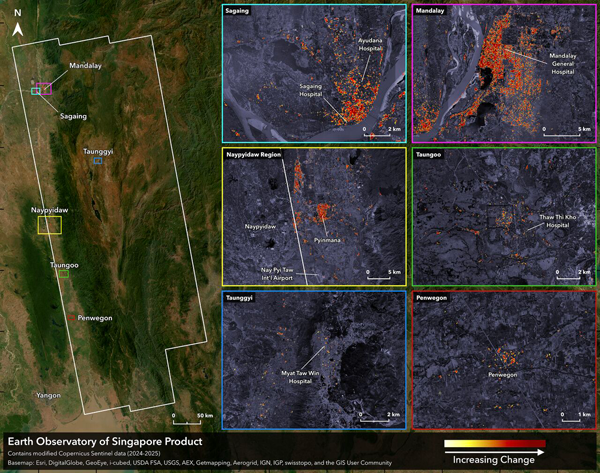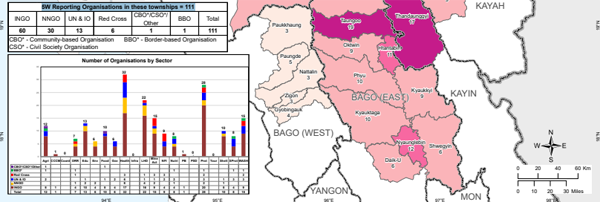An academic report titled "In the Wake of the March 28, 2025 Myanmar Earthquake" has been released on ResearchGate. It brings together key findings on tectonic activity, past seismic events, and the wider social and economic impact. The report highlights the need for better seismic monitoring, safer building codes, and stronger international cooperation on disaster risk reduction.
News
Following the Myanmar earthquake, a mapping campaign was launched to contribute data on OpenStreetMap. Over the past 8 days, the Humanitarian OpenStreetMap Team (HOT), the local Myanmar OSM community (myOSM), and more than 1,032 volunteers have come together to map 307,277 buildings and 4,934 km of roads.
Many other affected townships still need mapping. Check out the HOT Tasking Manager for available tasks. Every contribution counts and is deeply appreciated.
The United Nations Satellite Centre (UNOSAT) has released more results from their assessment of structures potentially damaged by the recent Sagaing Earthquake. Using very high-resolution Pleiades satellite imagery, UNOSAT analysed areas in the Sagaing and Mandalay Regions.:
- Within an analysed area of ~270 km² in Wundwin Township, Mandalay Region, UNOSAT identified 325 damaged structures and 672 potentially damaged structures.
Please Note: This is a preliminary analysis based on satellite imagery and has not yet been validated in the field. UNOSAT welcomes ground feedback to refine the assessment.
CEMS has released more remote sensing products for Sagaing Earthquake Response. 22 areas of interest (AOI) have been analysed (out of 28 requested AOIs, more coming) with an estimated 5,059 buildings and 2.8 km of roads affected. More on the CEMS page.
Building on UNOSAT’s preliminary analyses and satellite imagery from THEOS-2 and Maxar, MIMU, with technical support from the Asian Disaster Preparedness Center (ADPC), has developed a map showing probable damaged buildings in Mandalay and Sagaing areas. To improve accuracy, MIMU also used some field validation from MIMU staff on the ground. Within the analysis area, 1,853 buildings were identified as destroyed/damaged and 2,290 as possibly damaged.
Timely logistics information is important during disasters, and to meet this critical need, the Logistics Cluster has released an interactive map focused on the latest situation in Myanmar.
This will provide updates on:
- Situation Monitoring: Offering current updates on emergency situations, including floods, cyclone paths, earthquakes, and damage assessments.
- Physical Access Constraints: Providing details on the condition of roads, rivers, and bridges impacted by damage, flooding, or landslides.
- Waste Management & Recycling: Presenting an overview of waste management facilities, recycling capabilities, and best practices, mapped by the WREC project.
Read the latest situation report from Logistics Cluster.
Earth Observatory of Singapore (EOS) recently released a comprehensive Damage Proxy Map (DPM) covering approximately 158,000 square kilometres, including Mandalay and many other cities and small towns in Myanmar near the fault rupture that caused the Mw7.7 earthquakes on 28 Mar 2025. The map was derived from SAR data acquired on 3 Apr 6:09 PM local time from the Copernicus Sentinel-1 satellites operated by the European Space Agency (ESA). The figure below shows an illustrative image of the map, and the map can be downloaded from this webpage (filenames: EOS-RS_20250403_DPM_S1_Myanmar_Earthquakes_v0.9.kmz and .tif)
The KMZ file is very light and portable (25 KB), making it useful for viewing the maps in the Google Earth app on mobile devices used by on-the-ground teams for field operations.
The GeoTIFF file is large (~1 GB) and can be drag-and-dropped into GIS software (e.g. QGIS or ArcGIS) for further analysis in support of decision-making efforts.
- Interactive Dashboard of Latest Earthquakes - Explore recent and historical earthquakes in and near Myanmar since Apr 2007 - useful for monitoring aftershocks
- HDP Nexus 5W Map - snapshot of agencies’ activities in intense earthquake townships
Please let us know if you have any questions or additional information that we should include. Thank you for your continued support in these trying times.
Explore recent and historical earthquake activity in Myanmar and surrounding areas with this interactive dashboard. Using available data since April 2007, this aims to provide insights into earthquake frequencies, magnitudes, and trends within the region. Features include:
- Interactive Map: See the location and magnitude of individual earthquakes, color-coded for magnitude.
- Time Period Selection: Use the slider to focus on specific date ranges (since April 2007 to today).
- Magnitude Breakdown: Analyse the distribution of earthquakes by magnitude for your selected period.
- Historical Trends: View earthquake frequency month-by-month and year-by-year since April 2007.
- Data Filtering: Click on magnitude ranges or specific months/years in the charts to refine the displayed data.
- Summary Statistics: Get quick counts of total events and significant earthquakes (Magnitude 5.0+) within the selected period.
This dashboard will be updated regularly based on data from the Thai Meteorological Department (TMD) and the United States Geological Survey (USGS). TMD data includes more localised earthquakes but less accurate and has discrepancies compared to USGS data.
Based on contributed data from HDP Nexus 5W partners, we have released a new map showing a snapshot of activities prior to the earthquake in townships that experienced an intensity of 6 or above on the Modified Mercalli Intensity Scale. A total of 111 organisations are reported to be working in these townships. Explore the map for more details.
You may also download the list of these townships. (Download here)
- ‹ previous
- 4 of 10
- next ›

